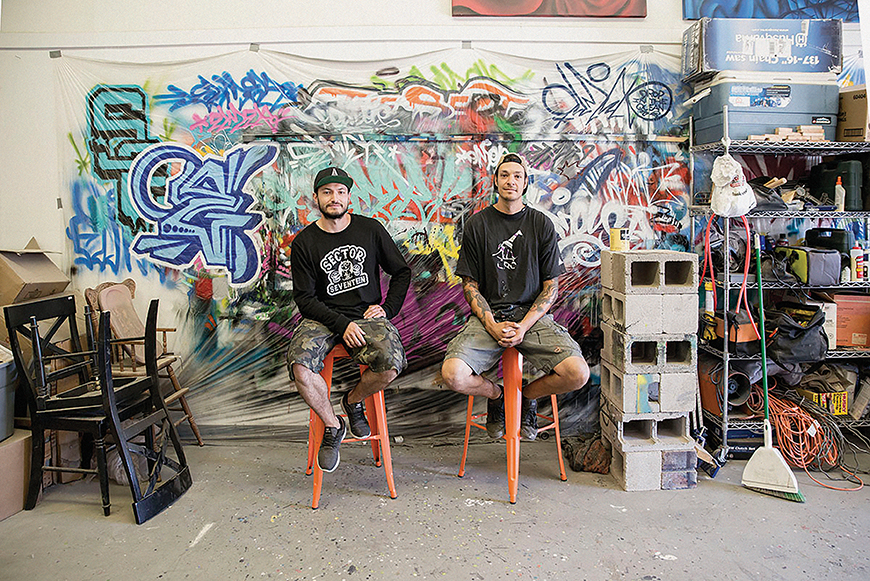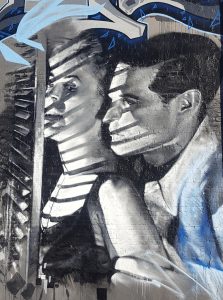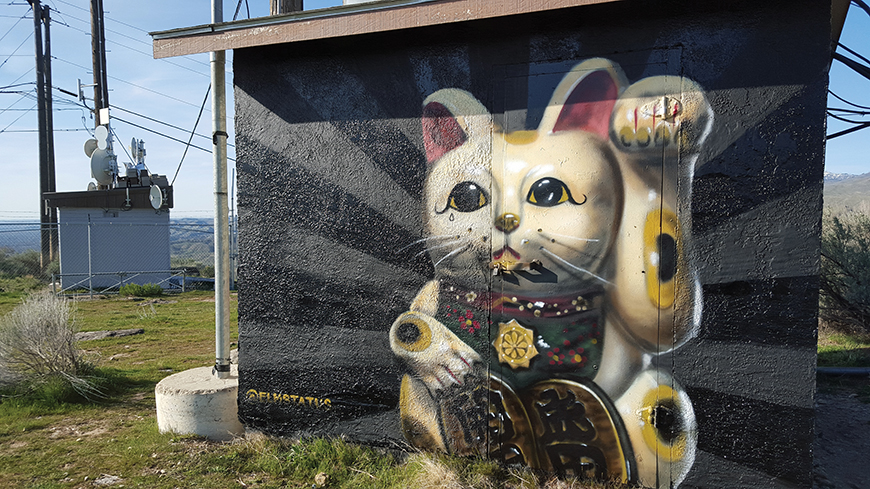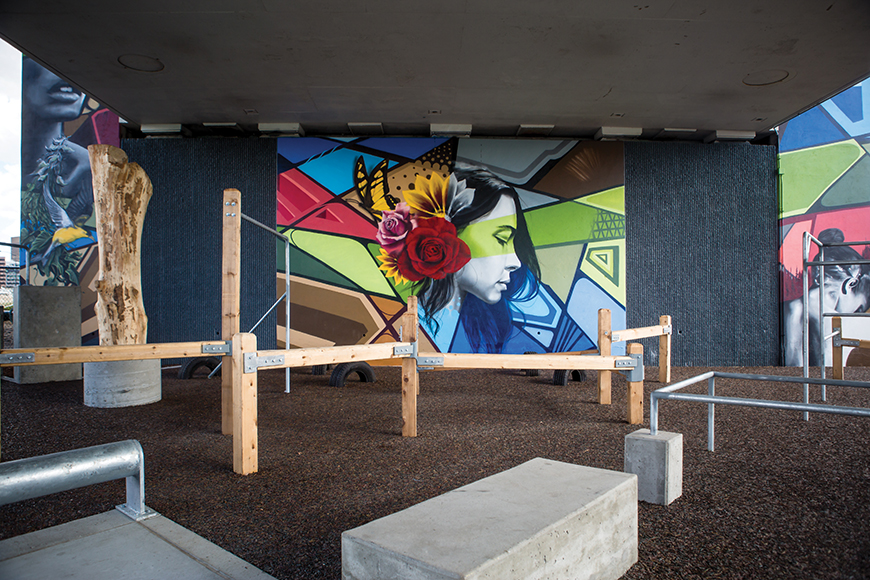The vibrant colors and graffiti-style lettering and designs in some of their work might be exactly what people would expect to come from a can of spray paint. On the other hand, it might be hard to believe their and the realism they incorporate in other projects could be done in the same way.
The duo of Hawk Sahlein and Collin Pfeifer have turned their talent with aerosol artwork into a successful business, completing large-scale projects for the city, local real estate developers, business owners and nonprofit organizations.
“We’ve been able to catch a really nice wave in Boise in terms of people recognizing that style of art and also Boise growing at a crazy pace, and it’s coalesced for us into a pretty nice ride,” Sahlein said.
On a recent day in Sector Seventeen’s paint-splattered warehouse, Sahlein and Pfeifer were working on two canvases that hung on a wall of the warehouse. One canvas had a portrait of a friend’s child. The other canvas was a creation commissioned by a local organization called Healing Children. That one featured a crocus rising above brain waves. It was meant to symbolize something beautiful emerging from toxic thoughts.
Holding a paint can in one hand and a printout of the design created in Photoshop, Sahlein carefully sprayed details onto the painting.
After working on those paintings, the artists were heading to paint walls in a new children’s museum in Meridian.

Solomon Hawk Sahlein (left) and Collin Pfeifer at the Sector Seventeen studio. Photo courtesy Sector Seventeen
Taking on Bigger Projects
Over the past few years, Sector Seventeen has been chosen for big projects in downtown Boise, including murals at Rhodes Skate Park and City Center Plaza.
“Those were larger projects where people really showed us they were willing to give us a large chunk of their real estate and let us do our thing,” Sahlein said.
Sector Seventeen posted a time-lapse video on their website that showed the process it took to create the large public art display at Rhodes Skate Park.
Using lifts, risers and ladders, the artists worked in small sections on the walls under the Connector. The video shows the progression that starts with a few black lines on the wall and ends with large blocks of color, portraits and abstract designs.
Sector Seventeen was asked to complete a large mural for the City Center Plaza in Boise. The mural spans a walkway that starts at Capital Boulevard across from the Basque Block and extends to the plaza.
That piece was created to honor the Faces of Hope Victim Center in Boise. Sahlein said the plaza’s developer, Gardner Company, asked the artists to tour the Faces facility and come up with an idea based on that experience.
The resulting mural is a narrative of personal growth and transition, he said. Sector Seventeen also recently painted a large wall inside the Faces facility.
“They’re a pretty outstanding organization,” Sahlein said.
For the past five years, the artists have worked with Treefort Music Fest doing live demos and painting temporary structures during the five-day festival. This exposure has also played an important role in the growth of Sector Seventeen.
“Treefort is such a homegrown Boise thing, and we connect on that wavelength,” Sahlein said. “Doing that aspect of a festival in Boise is really important to us to have a strong showing, and they’ve been cool with letting us kind of build that alongside of them.”
During last year’s festival, Sector Seventeen was joined by other artists in painting the entire west-facing outside wall of the Record Exchange in a piece that emphasized graffiti along with realism and portraiture in a celebration of styles.
Sahlein said he’s looking forward to more opportunities with Treefort and bringing other visual artists together.
The large downtown projects have motivated Sahlein to do even more like these, and he wants to see the city continue to embrace art the way it has. “I want to see Boise covered in all types of non-blank surfaces,” he said.

Mawk One’s portrait section on the collaboration wall of the Hitchcock Building in Boise.
An Early Start in Business
Sahlein’s interest in graffiti grew out of skateboarding and hip-hop when he was a teenager. “That culture blended together and exposed me to what I thought was just graffiti, but it ended up being a wider spectrum of painting,” he said.
Word spread about Sahlein’s and friend Jeff Patton’s talents at painting. They started to get requests for commissioned paintings. At that point—at the age of 17—they decided to make it official and named their new business Sector Seventeen. Pfeifer joined shortly after.
Since then, Sahlein said they’ve experienced a snowball effect with Sector Seventeen. They’ve accepted more jobs than not and participated in events to get their work in front of more people.
“We don’t limit ourselves to one particular style or form,” Sahlein said. “We know we can do a lot of different things from lettering and graffiti style, to realism, abstract and even sign-style projects. It’s nice to be able to say yes more than no.”
Even if it means taking on a project they might not want to do, Sahlein sees that as an opportunity to learn from different processes and expand what he’s capable of.
Regardless of the type or size of project, the Sector Seventeen artists put themselves into every project they do, he said.

Sector Seventeen has painted the telecommunications buildings at Table Rock.
PLAYING AT TABLE ROCK
Thanks to an agreement with the Boise Historic Preservation Society and Rotary Club of Boise East, Sector Seventeen gets to paint the telecommunication buildings at Table Rock as an ongoing project.
The agreement means Sector Seventeen can paint over other graffiti that might be on the buildings, instead of the groups having to clean it up.
This gives the artists an opportunity to experiment and invite other artists to join them.
“It works for everybody, because it keeps those walls fresh and it’s cool for people walking by to go check out new stuff,” Sahle

